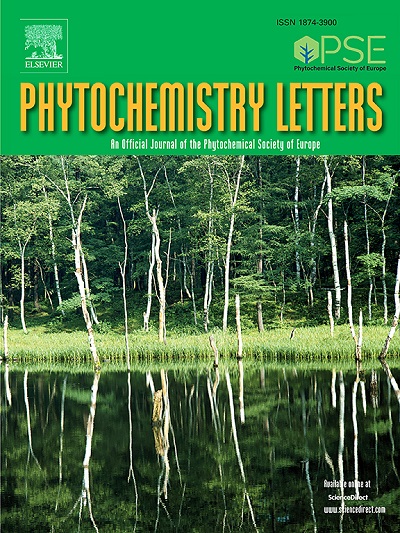Bidesmosidic triterpenoid saponins and other bioactive constituents from the stem bark of Pittosporum viridiflorum
IF 1.4
4区 生物学
Q4 CHEMISTRY, MEDICINAL
引用次数: 0
Abstract
Three previously unreported triterpenoid saponins namely pittosposides A–C (1–3), were isolated from the stem bark of Pittosporum viridiflorum, alongside nine known compounds 4−11. The structures were elucidated based on spectroscopic data as well as chemical conversions. The extract, fractions, and some isolated compounds were assessed for their antibacterial activity against sixteen multi-resistant bacterial strains. The extract and fractions exhibited good antibacterial activity on at least one of the tested strains. The EtOAc fraction was the most active against almost all the strains (MIC values, 15.6![]() 500 μg/mL). 2,6‑Dimethoxybenzoquinone (7) was active against almost all the selected bacterial strains with the best activity against E. coli ATCC35218 (MIC = 1.9 μg/mL). In addition, the extract, fractions, and compounds 1−4, 7, and 11 were assessed for their cytotoxic activity on the normal Vero cell line. Compounds 1, 2 and 4 were further assessed for their cytotoxic activity on the KB-3–1 cervical carcinoma cell line against which compound 4 displayed moderate cytotoxicity (IC50 = 23.9 μM). The chemophenetic significance of the isolates was discussed.
500 μg/mL). 2,6‑Dimethoxybenzoquinone (7) was active against almost all the selected bacterial strains with the best activity against E. coli ATCC35218 (MIC = 1.9 μg/mL). In addition, the extract, fractions, and compounds 1−4, 7, and 11 were assessed for their cytotoxic activity on the normal Vero cell line. Compounds 1, 2 and 4 were further assessed for their cytotoxic activity on the KB-3–1 cervical carcinoma cell line against which compound 4 displayed moderate cytotoxicity (IC50 = 23.9 μM). The chemophenetic significance of the isolates was discussed.
绿花Pittosporum viridiflorum茎皮中的Bidesmosidic三萜皂苷及其他生物活性成分
从Pittosporum viridiflorum的茎皮中分离出3种以前未报道的三萜皂苷,即pittospoides A-C(1-3),以及9种已知化合物4−11。根据光谱数据和化学转化对其结构进行了鉴定。对其提取物、馏分及部分分离化合物进行了抑菌活性测定。提取物和馏分对至少一种被试菌株表现出良好的抗菌活性。EtOAc组分对几乎所有菌株的抑菌活性最高(MIC值为15.6500 μg/mL)。2,6‑二甲氧基苯醌(7)对几乎所有的菌株都有活性,其中对大肠杆菌ATCC35218的活性最好(MIC = 1.9 μg/mL)。此外,对提取物、馏分和化合物1 ~ 4、7和11在正常Vero细胞系上的细胞毒活性进行了评估。化合物1、2和4对KB-3-1宫颈癌细胞株的细胞毒活性进行了进一步的评估,其中化合物4表现出中等的细胞毒活性(IC50 = 23.9 μM)。讨论了分离菌株的化学表型意义。
本文章由计算机程序翻译,如有差异,请以英文原文为准。
求助全文
约1分钟内获得全文
求助全文
来源期刊

Phytochemistry Letters
生物-生化与分子生物学
CiteScore
3.00
自引率
11.80%
发文量
190
审稿时长
34 days
期刊介绍:
Phytochemistry Letters invites rapid communications on all aspects of natural product research including:
• Structural elucidation of natural products
• Analytical evaluation of herbal medicines
• Clinical efficacy, safety and pharmacovigilance of herbal medicines
• Natural product biosynthesis
• Natural product synthesis and chemical modification
• Natural product metabolism
• Chemical ecology
• Biotechnology
• Bioassay-guided isolation
• Pharmacognosy
• Pharmacology of natural products
• Metabolomics
• Ethnobotany and traditional usage
• Genetics of natural products
Manuscripts that detail the isolation of just one new compound are not substantial enough to be sent out of review and are out of scope. Furthermore, where pharmacology has been performed on one new compound to increase the amount of novel data, the pharmacology must be substantial and/or related to the medicinal use of the producing organism.
 求助内容:
求助内容: 应助结果提醒方式:
应助结果提醒方式:


